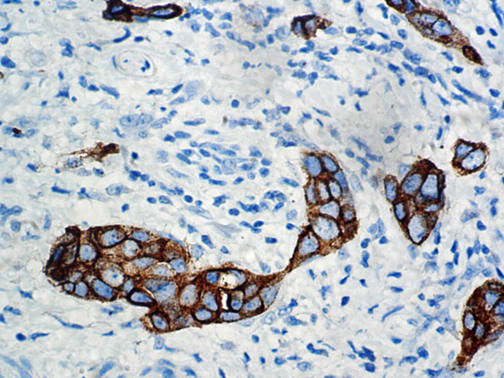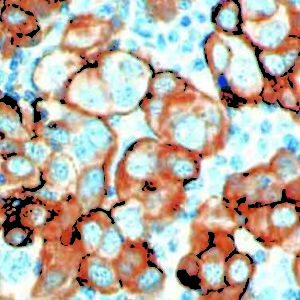
IHC of CA15-3 on an FFPE Breast Tissue
| Intended Use | For In Vitro Diagnostic Use | |||||||||||||||||||||||||||||||||||
| Summary and Explanation | This antibody has been used for evaluating the primary site of a metastatic carcinoma of unknown origin and distinguishing between benign and malignant lesions. It is believed that CA15-3 reacts primarily with the DF3-antigen, a 300 kDa mucin-like glycoprotein present on the apical border of secretory mammary epithelial cells. CA15-3 has been detected with immunohistochemistry in a wide spectrum of carcinomas, including Breast Carcinomas (ductal and lobular), Sarcomas (Synovial Sarcoma and Malignant Fibrous Histiocytomas), and Lung Carcinomas. CA15-3 can be used as a supplementary marker for epithelial differentiation. CA15-3 does not stain Melanomas or Ewing’s Sarcomas. Approximately 30% of Hepatocellular Carcinomas are positive for CA15-3. | |||||||||||||||||||||||||||||||||||
| Antibody Type | Mouse Monoclonal | Clone | DF3 | |||||||||||||||||||||||||||||||||
| Isotype | IgG1 | Reactivity | Paraffin, Frozen | |||||||||||||||||||||||||||||||||
| Localization | Cytoplasmic, Membranous | Control | Kidney, Breast, Pancreas, Lymph Node, Cervix, Salivary Gland, Bladder TCC | |||||||||||||||||||||||||||||||||
| Presentation | CA15-3 is a mouse monoclonal antibody derived from cell culture supernatant that is concentrated, dialyzed, filter sterilized and diluted in buffer pH 7.5, containing BSA and sodium azide as a preservative. | |||||||||||||||||||||||||||||||||||
| Availability |
| |||||||||||||||||||||||||||||||||||
| Note: For concentrated antibodies, please centrifuge prior to use to ensure recovery of all product. | ||||||||||||||||||||||||||||||||||||




